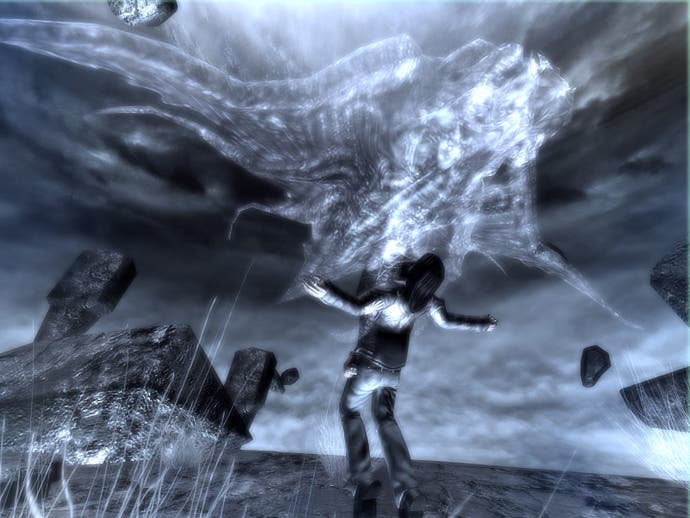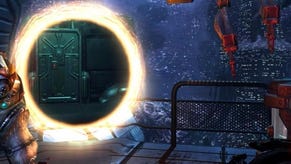Prey
Giger counter.
Spacious
This 'levels-as-puzzles' design philosophy becomes more prevalent as you progress, with entire areas of the game constructed around manipulating the environment or navigating it in unusual ways. For example, the ability to walk up certain designated chevron-marked surfaces evoked memories of the long-forgotten platform title Dr Muto (where you could transform into a spider and walk up specific surfaces to access otherwise unreachable areas), where the level design is, literally, turned on its head, forcing you to think about your destination in a completely different way. Much like the gravity switches, this concept gives each level a much more 3D feel, with enemies appearing in disorientatingly unexpected places (such as what appears to be the ceiling, but is actually the floor, etc.) and challenging you in ways we're not used to in first-person shooters.
And yet it's precisely here that being 'different' doesn't necessarily equate to 'better'. For the majority of the time, when Prey switches to 'contrived puzzle mode' it treads a fine line between being thought-provoking and just plain annoying at how prescribed such segments are. In what stacks up to being a pretty short 8-10 hour game, it's surprising how many times you end up snagged by one of the environmental puzzles. Surprising, because none of them are that hard in reality yet still have the capacity to become really annoying when you've spent ages trawling round and round searching for something that's been staring you in the face all along.
Meanwhile, the much-vaunted Portal technology is little more than a cunning marketing buzzword that sounds more profound and interesting than it really is. In truth, they mainly serve the purpose of being doors to a different part of a level, and as a result make very little difference to the gameplay in any meaningful sense. Sure, they look very cool - being able to peer into another location before you're there is a neat trick, and the ability to duck in and out of portals seamlessly between two locations with no loading pauses is a lovely sight to behold - but once you've done it a few times it's fundamentally just another way of getting around. The enemies you face also use their own portals, but only in the sense that they're ostensibly used as a cunning way of justifying why they are able to spawn right before your eyes. If enemies could chase you between portals, or you could use theirs, that would make more sense and be a cunning use of the tech. As things stand, it's just a means of making the game look cooler than it would otherwise.
Predictable

But all of this might be forgivable if the core combat was so intense that your memories of the game were littered with wide-eyed moments of awe. The truth is slightly more mundane than that, sadly, thanks to an arsenal of too-powerful weaponry and huge, predictable, lumbering foes who make it a perfunctory exercise to blast them to mincemeat within seconds of their appearance (including the various anticlimactic boss encounters). With the most casual use of circle-strafe and the abundance of available cover you'll easily avoid most enemy attacks and also get a surprisingly large window of opportunity to strike back. It's simple enough to keep backing away from chasing enemies, and it's no problem to avoid incoming rocket fire. And any game that rarely challenges you to take on more than two enemies at a time is just asking to be kicked.
Meanwhile, although just seven weapons make it into the game they're all a bit too powerful for their own good (apart from the entirely redundant wrench) and ammo is always plentiful. With skill, even the first proper projectile weapon (the relatively underpowered Hunter Rifle) seems capable of taking down most of the enemies you face, and without fail, by the time you do face anyone of any power, you'll be supremely well stocked with a brutally powerful arsenal to take care of them very quickly. Failing that, you can easily fall back on the cheatery of repeated regenerative Death Walks. Without exception, even average players will breeze through Prey with barely a pause for breath - in fact, you can expect to polish it off inside a day if you're determined.
In technical terms, Prey rarely rises above 'satisfactory', and looks every inch the medium range PC port that it is. The interior environments of the sprawling spaceship certainly appear detailed and impressive at first glance, but quickly get samey and - rather like Doom 3 - aren't especially interactive. There's almost nothing in the way of destructible scenery, physics barely even figures in the entire game and the majority of it takes place in small, enclosed, darkened environments that make it feel just like any other corridor-based shooter you care to mention. Fair enough, the occasional flying sortie around the more cavernous parts of the ship adds a fleeting sliver of welcome variety, but it's frankly not enough to make you want to tell all your friends that you've seen the future of the genre.
Prey tell

And apart from the amusing licensed jukebox inclusions at the very beginning of the game, the soundtrack is entirely forgettable watery string-based sci-fi fodder that noodles just outside your consciousness whenever the action amps up. Depressingly, the voice acting is shockingly run-of-the-mill amateur dramatics fare which adds little to any attempt to build the atmosphere. We wish we could be kinder to a game we've been really looking forward to for ages, but the closer you examine Prey, the more disappointing it gets.
At the end of Prey you'll probably just feel a little blank. Its tendency to lapse into generic blandness might be acceptable on boring days in July with no other games to focus on, but it'd have to a fairly rainy one at that. Even with our feel-good glasses on it feels like we're damning Prey with faint praise to write a sentence that ends with "reasonably entertaining few hours of gunplay that never really stretches you". More likely, you'll mutter to your mates in the beer garden that you're glad that you got through all those slightly irritating, rarely satisfying puzzling sections without having to resort to a guide, and feign surprise as the subject gets changed in an instant. Back home, you'll wonder why anyone made a fuss about the storyline in the first place, wonder what 3D Realms really think about it, and sit the summer months out, waiting patiently for the next developer to do something truly surprising in the FPS genre.
Perhaps inevitably - although maybe not intentionally - Prey struggles to break free of its late '90s genesis, and essentially what we're left with is a game whose good intentions simply don't translate into wide-eyed entertainment. With uninspiring and basic deathmatch multiplayer options failing to rescue the package, it looks like it's going to be another long hot summer for FPS devotees.













